Modified Stoppa approach is effective for fixing acetabular fractures from the front
The anterior intrapelvic approach or modified Stoppa approach for the treatment of pelvic and acetabular fractures has been gaining popularity. This approach now rivals the ilioinguinal approach as the workhorse approach for most orthopedic trauma surgeons who want to gain access to the anterior pelvis and acetabulum. Its advantages include ease of surgical dissection, excellent access to the quadrilateral plate, good visualization of a portion of the posterior column and, when combined with a lateral window, visualization of the entire anterior column. The modified Stoppa approach can be performed in isolation (without the need for the lateral window) when the iliac wing is not fractured.
Like all surgical approaches, the modified Stoppa is a means to achieve anatomical reduction and surgical fixation of the fracture. It is therefore critical to enhance access while protecting the critical neurovascular structures to allow clamp placements and insertion of plate and screws. The aim of this technique article is to focus on and present our 11 critical steps to perform a safe anterior intrapelvic (AIP) approach. To this aim, we present the case of a 60-year-old patient with an anterior column, posterior hemi-transverse acetabular fracture (Figures 1, 2 and 3) treated with an AIP approach and a retrograde percutaneous posterior column screw.
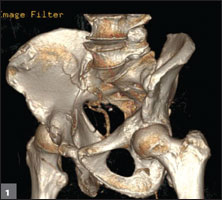
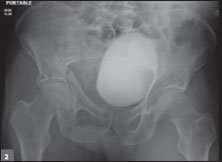
Positioning
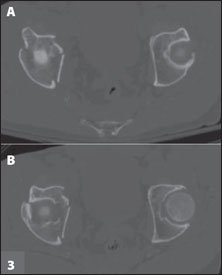
The patient is positioned supine on a radiolucent table with the affected extremity freely prepared and draped. A Foley catheter must be placed to decompress the bladder and decrease the risk of injury during retraction. Draping widely is crucial to ensure proper access and orientation during the procedure. The umbilicus is exposed in the surgical field because it is the best visible landmark for the midline. Enough lateral and superior access is left to make a lateral window, if needed. The surgeon stands on the contralateral side of the fracture. When traction is required, we use distal femoral traction (Figure 4) with a pin, traction bow and sterile rope that is attached to a bucket with sand bags. A 5-inch to 7-inch transverse incision is marked two fingers breadth proximal to the pubic symphisis (Figure 5).

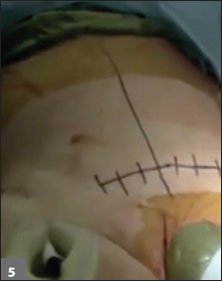
Surgical approach

The skin and subcutaneous fat are incised and a proximal subcutaneous skin flap is developed (step 1). This dissection will greatly improve access to the fracture site. Next, the linea alba is split between the two heads of the rectus abdominis muscle (step 2). This split will be extraperitoneal if it remains within about 10 cm of the pubis symphysis. The ipsilateral rectus abdominis insertion onto the superior ramus is then detached to the pubic tubercle (Figure 6A) to place a Hohmann retractor (step 3) in this area (Figure 6B). In Figure 6B, the iliopectineal fascia represented by the sheet of white paper, the corona mortis artery, the external iliac vessels and the obturator nerve can be recognized. A wide malleable retractor and lap sponge is placed anterior to the bladder at all times to avoid injury (step 4). The focus is then directed to the identification and cauterization or ligation of the vascular anastomosis between the external iliac and obturator systems (step 5). This may include large veins or a corona mortis artery. These vessels are often found about 4 cm lateral to the midline running along the posterior aspect of the superior pubic ramus. We then move laterally using a Cobb elevator on the pelvic brim to place the iliopectineal fascia under tension. At this time, one must ensure to have placed a sterile bump under the knee to flex the hip and relax the neurovascular structures and iliopsoas muscle that crosses the hip joint anteriorly. With a Cobb elevator protecting the laterally located iliac vein and artery, a long-handled scalpel is used to incise this fascia (Figure 7) from posterior to anterior following the pelvic brim (step 6).
In our opinion, this latter step is one of the most critical maneuvers to gain sufficient access to the fracture. Incomplete section of the iliopectineal fascia will make access to the fracture, the ability to reduce the fracture and the placement of hardware extremely challenging. This maneuver allows a second Hohmann retractor to be placed under the iliopectineal fascia (Figure 8) toward the anterior inferior iliac spine (step 7). This step is not without risk of injury to the neurovascular structures. The third Hohmann retractor goes as far posterior and lateral on the ilium ensuring that the iliac vein and artery are protected (step 8). At this point, we place the malleable retractor on the lateral surface of the bladder and apply gentle retraction, which will help visualize the obturator neurovascular structures (Figure 9), which are protected throughout the case (step 9). A fourth retractor placed in the lesser sciatic notch (Figure 10) will create a good view of the entire quadrilateral plate (step 10). The obturator internus muscle must be bluntly detached from its origin on the quadrilateral plate (step 11).
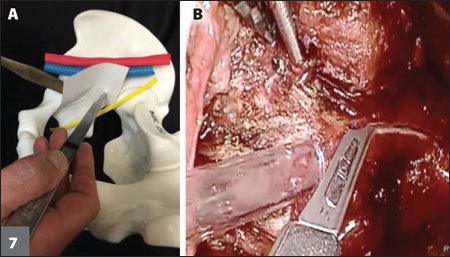
Fracture reduction and fixation

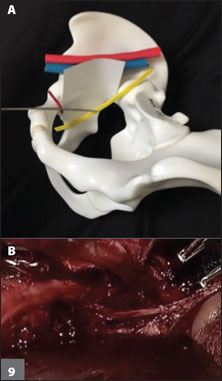
Reduction maneuvers are based on the fracture type being treated. Various clamps can be placed through the AIP window alone or in combination with percutaneous placement onto the outer table or a fully developed lateral window. We favor the use of Weber clamps and ball spike pushers (Figure 11), along with axial lateral traction pulled through the distal femur and greater trochanter, respectively. Additional strategies include the use of cortical screws and Jungbluth clamps, which work well around the anterior column. Cortical screws as a reduction tool are useful around the quadrilateral surface. In fact, the smooth surface and orientation of the quadrilateral plate make it difficult to place clamps. A screw inserted distal to the transverse fracture creates a point of anchor for a reduction clamp. A more expensive option is the use of a collinear clamp. The reduction is then held with K-wires temporarily.

Lag screws, small one-third tubular plates, reconstruction plates followed by the placement of a neutralization plate can then be utilized. Many plating options are now available that range from traditional reconstruction plates to newer pre-formed specialty plates. One concern with pre-contoured plates is that these must be used as a neutralizing construct. In fact, without placement of a lag screw first across the fracture, there is a concern that such bulky pre-contoured plates, which are not always perfectly contoured to the patient’s anatomy, may bring the bone to the plate and displace the fractures. Our current strategy is to use lag screws and/or a one-third tubular or reconstruction plate to maintain anatomical reduction (Figure 12) prior to placement of a pre-contoured neutralizing plate. This is usually done in an antiglide mode depending on the fracture configuration.
Fluoroscopy will help confirm the quality of the reduction and fixation, as well as the screw placement. Anteriorposterior (AP), inlet/outlet and Judet views must not be underestimated for the intraoperative assessment of reduction and fixation. The AP view is our first choice to determine a quality column reduction (Figure 13). Judet views are used to confirm wall reduction and confirm that no screws have violated the joint (Figure 14) and an inlet view shows the symmetry of the ring and correction of a protrused quadrilateral plate, when present.
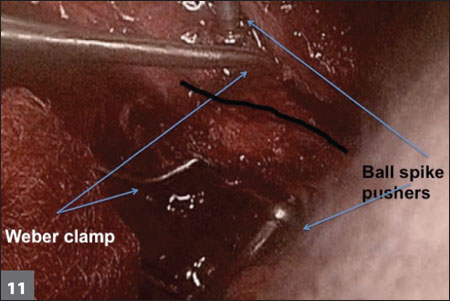
Closure, postoperative aspects
The wound is thoroughly irrigated and closed in layers. The split in the linea alba is closed using a braided suture in an interrupted fashion. We typically do not use a drain. In the absence of an anterior or posterior wall fracture, we typically let patients weight-bear as tolerated. Postoperative CT scans are obtained routinely to ensure safe hardware placement and reduction quality (Figure 15). Patients are started on prophylactic low-molecular-weight heparin for 2 weeks and followed up at 2 weeks, 6 weeks, 12 weeks and 6 months postoperatively. Physical therapy is started at week 6.

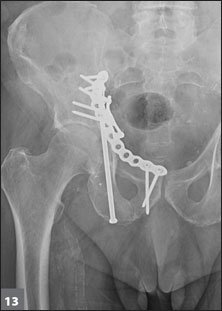
Conclusion
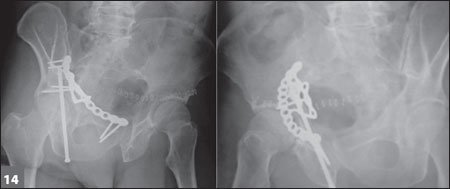
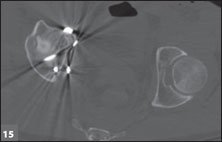
The AIP approach is a useful tool in the treatment of acetabular and pelvic fractures requiring access from the front. It can be used in isolation or in combination with other approaches to treat these complex injuries. Familiarity with this approach will allow for a safe procedure and increase the odds of successful reduction and fixation, and ultimately a good outcome. Familiarity with this approach has fostered some new developments, such as laparoscopy-assisted reduction of transverse acetabular fractures.
- References:
- This surgical technique can be viewed at: https://www.vumedi.com/video/modified-stoppa-approach-for-fractures-of-the-acetabulum/
- Archdeacon MT, et al. J Am Acad Orthop Surg. 2011;19:170-175.
- Bible JE, et al. J Orthop Trauma. 2014;doi:10.1097/BOT.0000000000000032.
- Guy P. J Orthop Trauma. 2015;doi:10.1097/BOT.0000000000000269.
- Mauffrey C, et al. Injury. 2016;doi:10.1016/j.injury.2016.06.033.
- For more information:
- Nicholas A. Alfonso, MD, can be reached at University of Colorado School of Medicine, 777 Bannock St., Denver, CO 80204; email: nicholas.alfonso@ucdenver.edu.
- Mark E. Hake, MD, can be reached at Department of Orthopaedics, University of Michigan, 1500 E. Medical Center Dr., 2912 Taubman Center, Box 5328, Ann Arbor, MI 48109; email: mehake7@yahoo.com.
- Austin Heare, MD, can be reached at University of Colorado School of Medicine, 777 Bannock St., Denver, CO 80204; email: austinheare@gmail.com.
- Cyril Mauffrey, MD, FACS, FRCS, can be reached at University of Colorado School of Medicine, 777 Bannock St., Denver, CO 80204; email: cyril.mauffrey@dhha.org.
Disclosures: Mauffrey reports he is a consultant for Stryker. Alfonso, Hake and Heare report no relevant financial disclosures.
